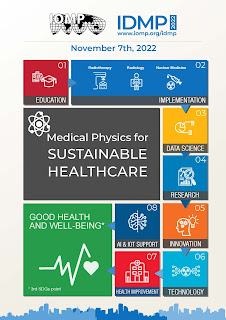 |
| The poster for the 2022 International Day of Medical Physics |
Monday, November 7, is the International Day of Medical Physics. The purpose of this annual event, organized by the International Organization for Medical Physics, is to raise awareness about the role that medical physics plays in our lives. The date coincides with the birthday of Marie Curie.
 |
| The Search for the Elements, by Isaac Asimov. |
Thomson, Roentgen, Becquerel, and Rutherford all received Nobel prizes for their work. But the most glamorous of all the Nobel laureates of the turn of the century was Marie Curie, born Marja Sklodowska in Poland in 1867. Marie went to Paris to get an education (at the Sorbonne), and there she met and married a French chemist, Pierre Curie.
Becquerel’s discovery of the radiations from uranium fascinated Marie; it was she who suggested the term “radioactivity.” With enthusiasm and imagination, she plunged into a career of investigating this phenomenon. Marie began by trying to measure the strength of radioactivity. As the instrument of measurement she used the phenomenon of piezoelectricity, involving the electrical behaviors of crystals, which had been discovered by Pierre Curie. Pierre, realizing perhaps that his wife was a greater scientist than he was, abandoned his own research and joined her.
As they measured the radioactivity of samples of uranium ore, they found to their surprise that some samples were many times more radioactive than could be accounted for by the uranium content. This could only mean that other radioactive elements also were present. But if so, the amount must be extremely small, because the Curies were unable to detect any by ordinary chemical analysis. So they decided they would have to collect huge quantities of the ore to get enough of the trace material to analyze. They managed to get tons of ore from the mines in Bohemia; the Austrian government had no use for it and was glad to give it away, provided the Curies paid for the transportation. This took almost all their life savings.
They set up shop in a little unheated shed and went to work on their mounds and mounds of uranium ore. Year after year they kept concentrating the radioactivity, discarding inactive material and working with the active. (Marie took time out to have a baby, Irene, who later turned out to be a great scientist on her own.) At last, in July 1898, they succeeded in boiling down their tons of ore to a highly radioactive residue. What they had was a pinch of black powder which was 400 times more radioactive than the same quantity of pure uranium would have been. In this bit of stuff they found a new element resembling tellurium. Mendeleev might have named it “eka-tellurium.” The Curies called it “polonium,” after Marie’s native land.
This element didn’t account for all the radioactivity, however. A still more active element must be hiding in their ore. Six months later they finally concentrated that element. Its properties were like those of barium. The element fitted into row IIa in the seventh period of Mendeleev’s table. It was the first new element discovered in the seventh period since Berzelius had found thorium 60 years before.
The Curies called the new element “radium,” because of its powerful radioactivity.
Pierre Curie died in 1906 as the result of a traffic accident (involving a horse-drawn cab, not one of the new-fangled motor cars). Marie took over his professorship at the Sorbonne and carried on alone. She was the first woman professor in the history of that proud institution. Moreover, she was the only scientist in history to receive two Nobel prizes—one in physics (shared with her husband and Becquerel) for their accurate measurements of radioactivity, and one in chemistry for the discovery of polonium and radium.
International Organization of Medical Physics President Message on the International Day of Medical Physics 2022.
https://www.youtube.com/watch?v=LZcEZYkUsCo
Marie Curie: Scientist
https://www.youtube.com/watch?v=ZEV4KJBJvEg



No comments:
Post a Comment